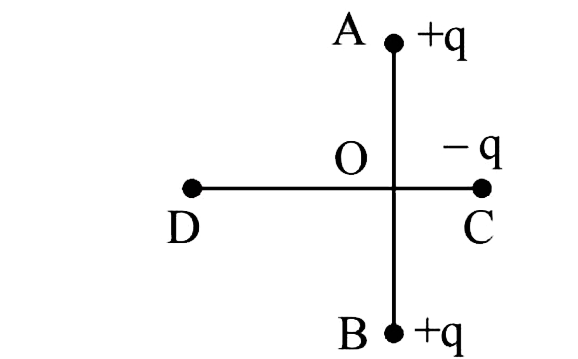In some old texts it is mentioned that 4π lines of force
. orginate form each unit positive charge. Comement on
. the statement in view of the fact that 4π is not an
. interger.
To address the question regarding the statement that "4π lines of force originate from each unit positive charge," we can break down the explanation into several steps:
1. Understanding Electric Field Lines: Electric field lines are a conceptual tool used to visualize the electric field created by charges. They represent the direction and strength of the electric field around a charge.
2. Solid Angle Concept: In three-dimensional space, the total solid angle around a point is measured in steradians. The total solid angle for a sphere is 4π steradians.
3. Field Lines and Solid Angle: When we say that 4π lines of force originate from a unit positive charge, we are referring to the idea that these lines spread out uniformly in all directions around the charge. Each line represents the direction of the electric field at that point in space.
4. Interpretation of 4π: The statement that "4π lines of force" does not imply that there are exactly 4π physical lines. Instead, it indicates that the field lines are distributed uniformly over the entire solid angle of 4π steradians.
5. Non-integer Nature of 4π: The fact that 4π is not an integer does not detract from its meaning in this context. It is a mathematical representation that captures the concept of the total field lines emanating from the charge in a spherical manner.
6. Conclusion: The statement is a way to express the uniform distribution of electric field lines around a point charge, emphasizing that the lines extend in all directions rather than suggesting a literal count of lines.
Topper's Solved these Questions
- ELECTRIC FIELD AND POTENTIALBOOK - HC VERMA ENGLISHCHAPTER - ELECTRIC FIELD AND POTENTIALEXERCISE - Objective 1
9 Videos
- ELECTRIC FIELD AND POTENTIALBOOK - HC VERMA ENGLISHCHAPTER - ELECTRIC FIELD AND POTENTIALEXERCISE - Objective 2
7 Videos
- ELECTRIC FIELD AND POTENTIALBOOK - HC VERMA ENGLISHCHAPTER - ELECTRIC FIELD AND POTENTIALEXERCISE - Exercises
75 Videos
- ELECTRIC CURRENT THROUGH GASESBOOK - HC VERMA ENGLISHCHAPTER - ELECTRIC CURRENT THROUGH GASESEXERCISE - Short answer
6 Videos
- ELECTROMAGNETIC INDUCTIONBOOK - HC VERMA ENGLISHCHAPTER - ELECTROMAGNETIC INDUCTIONEXERCISE - Questions for short answer
9 Videos
Similar Questions
If ˆa,ˆb,andˆc are three unit vectors inclined to each other at angle θ, then the maximum value of θ is π3 b. π4 c. 2π3 d. 5π6
View SolutionThe plane denoted by π1:4x+7y+4z+81=0 is rotated through a right angle about its line of intersection with the plane π2:5x+3y+10z=25. If the plane in its new position is denoted by π, and the distance of this plane from the origin is √k , where k∈N , then k=
View SolutionEach question has four choices, a,b,c and d,out of which only one is correct. Each question contains STATEMENT 1 and STATEMENT 2. if both the statements are true and statement 2 is the correct explanation of statement 1. If both the statements are true but statement 2 is not the correct explanation of statement 1. If statement is True and statement2 is false. If statement1 is false and statement2 is true. Statement 1: If x∈[1,√3], then the range of f(x)=tan−1x is [π4,π3] Statement 2 : If x∈[a,b], then the range of f(x)is[f(a),f(b)].
View SolutionA conducting sphere A of radius a, with charge Q, is placed concentrically inside a conducting shell B of radius b. B is earthed. C is the common center of AandB. Study the following statements.
(i) The potential at a distance r from C, where
a≤r≤b,is14πε0(qr)
(ii) The potential difference between AandB is
14πε0Q(1r−1B)
(iii) The potential at a distance romC, where
a≤r≤b,is14πε0Q(1r−1B)
Which of the following statements are correct ?
 .
.
View SolutionTwo fixed, equal, positive charges, each of magnitude 5×10−5 coul are located at points A and B separated by a distance of 6m. An equal and opposite charge moves towards them along the line COD, the perpendicular bisector of the line AB.
The moving charge, when it reaches the point C at a distance of 4m from O, has a kinetic energy of 4 joules. Calculate the distance of the farthest point D which the negative charge will reach before returning towards C.

View SolutionThe point (4, 1) undergoes the following three transformations successively: (a) Reflection about the line y = x (b) Translation through a distance 2 units along the positive direction of the x-axis. (c) Rotation through an angle π4 about the origin in the anti clockwise direction. The final position of the point is given by the co-ordinates.
View SolutionThe point (4, 1) undergoes the following three transformations successively: (a) Reflection about the line y = x (b) Translation through a distance 2 units along the positive direction of the x-axis. (c) Rotation through an angle π4 about the origin in the anti clockwise direction. The final position of the point is given by the co-ordinates.
View SolutionAt time t second, a particle of mass 3 kg has position vector r metre, where r=3tˆi−4costˆj. Find the impulse of the force during the time interval 0≤t≤π2
View SolutionAt time t second, a particle of mass 3 kg has position vector r metre, where r=3tˆi−4costˆj. Find the impulse of the force during the time interval 0≤t≤π2
View SolutionEach question has four choices a,b,c and d out of which only one is correct. Each question contains Statement 1 and Statement 2. Make your answer as: If both the statements are true and Statement 2 is the correct explanation of statement 1. If both the statements are True but Statement 2 is not the correct explanation of Statement 1. If Statement 1 is True and Statement 2 is False. If Statement 1 is False and Statement 2 is True. Statement 1: sin(π18) is a root of 8x3−6x+1=0 Statement 2: For any θ∈R,sin3θ=3sinθ−4sin3θ
View Solution
